Gluten-Free Chikuzenni Recipe (Japanese chicken and vegetables simmered in a soya sauce flavoured broth)
Share
Chikuzenni or Chikuzen-ni is a popular dish in Fukuoka Prefecture in the northern part of Kyushu Japan. It is often served at New Year's. My family loves this dish. I always make it for New Year's. It can be eaten anytime of year and is a comforting dish in the winter.
It is thought that this dish got it's name from Chikuzen Province which was an old province of Japan now known as Fukuoka Prefecture.
Chikuzenni is slowly simmered chicken and root vegetables in a slightly sweet, savoury soya sauce based broth. The ingredients are sauted first and then boiled in a broth. It is cooked until the vegetables are tender and the broth has decreased by at least half.
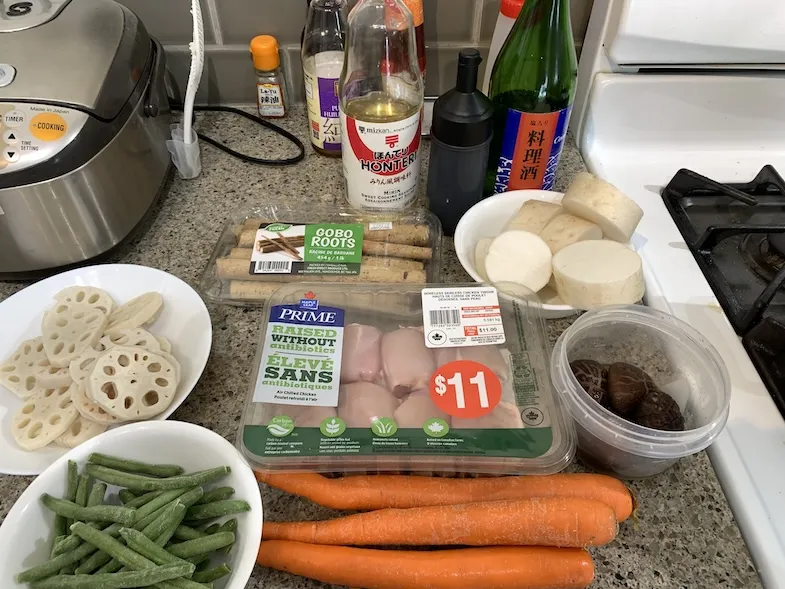
Above are the ingredients I used this time. My chikuzenni changes depending on the ingredients I can find where I live. You can also use taro, or bamboo. Traditionally chicken, burdock, lotus root, carrot, mushroom and konnyaku are used. I couldn't find konnyaku, so I have not used it this time.
Konnyaku is made from a type of yam called devil's tongue or konjac. It is gluten-free. It is a good source of fiber. In Japan it is referred to as "inohouki" the "broom of the stomach". It helps you to be regular.
It is made into different forms, the usual block type used in this recipe, and then other shapes such as balls, or noodle shapes called shirataki. It has a rubbery consisitancy and no flavour. It does smell fishy when the package is first opened and that is why it should be rinsed, parboiled and rinsed again before using in recipes. There is no fish in the product. The fishy smell is actually the natural occuring smell of the konjac root mixed with water. It can be an acquired taste because of the texture, but I love it. Konnyaku comes in two colours: slightly grey or white. The greyish colour can be a konnyaku made from unprocessed konjac or usually nowadays has a type of seaweed added to give it that colour. The white is made from processed konjac.
Do eat konnyaku in moderation. It is a good source of fiber, but eating huge amounts has been known to cause gastrointestinal distress. Here is an interesting article by www.livestrong.com on the side effects of konjac.
Every family has their own version of Chikuzenni. Using different vegetables and some liking it sweeter or salter. Adjust to your families tastes.
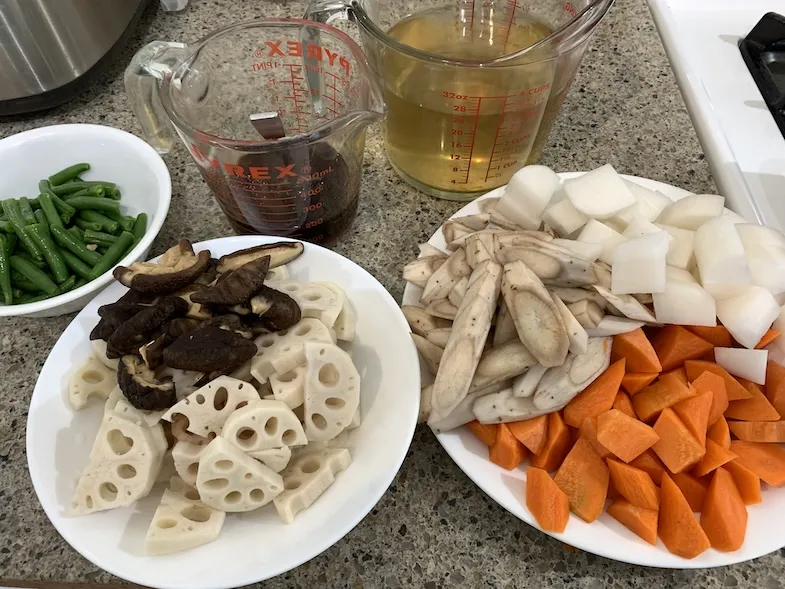
Here are the ingredients chopped into bite-sized pieces.
I usually use dried shiitake mushrooms and the soaking liquid, but you can use fresh shiitake mushrooms too. If I use fresh mushrooms, I like to add shiitake mushroom dashi to the broth along with the fish dashi powder, to give the dish a deeper umami flavour.
I use frozen renkon (lotus root) because fresh lotus root are hard to find where I live. You can use fresh lotus root. It will need to be peeled, and well washed.
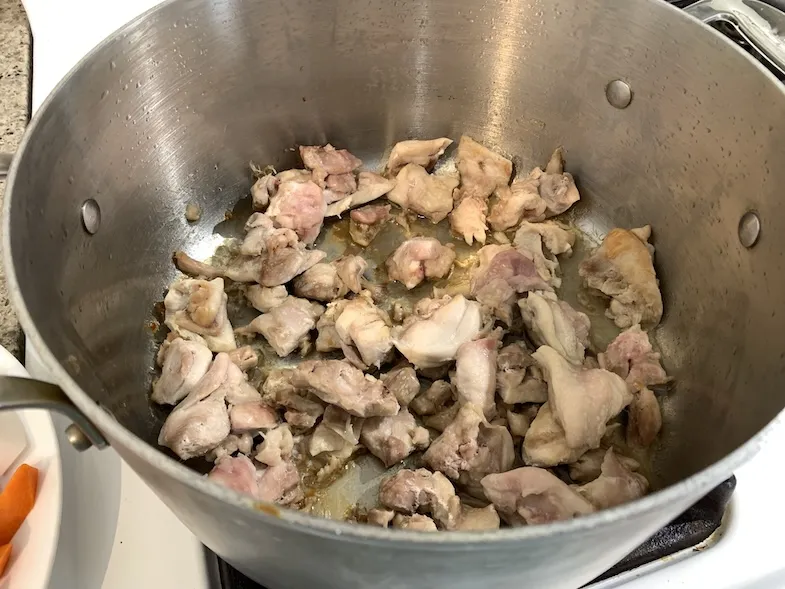
Fry the chicken first in some vegetable oil. This time I used chicken thigh, but I sometimes use chicken breast too. You can use chicken with or without the skin, it is up to your preference.
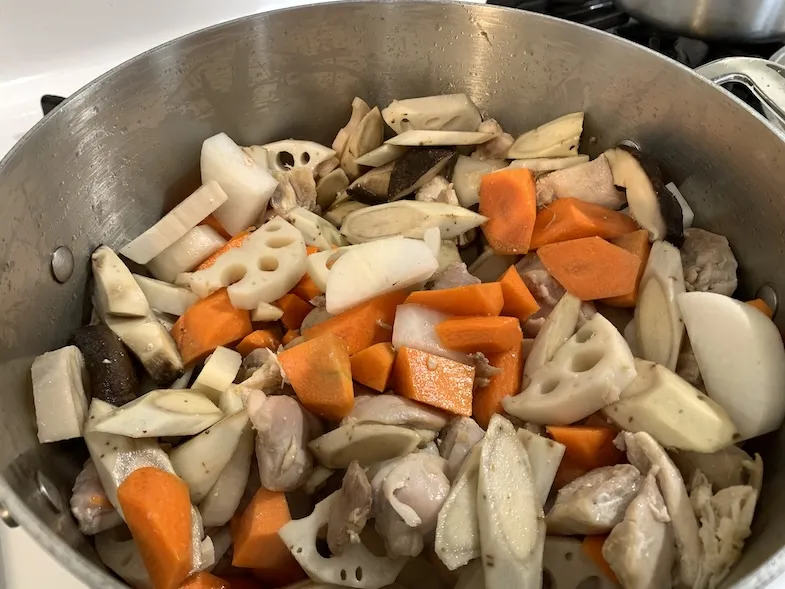
After the chicken has browned, add the vegetables except the green beans or snow peas. Saute the vegetables and konnyaku for about 5 minutes. The green beans or snow peas are added during the last 5 minutes of cooking. This is because they don't need long and you want to retain their green colour.
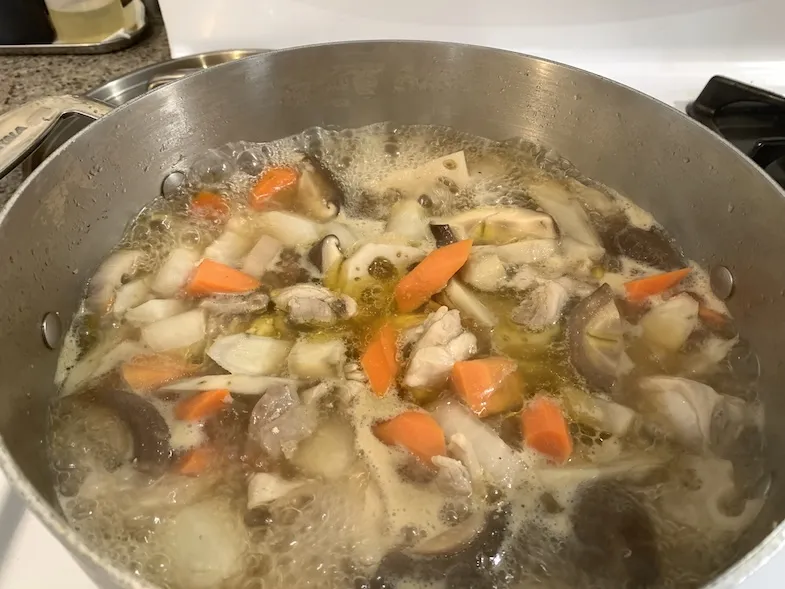
Strain the mushroom soaking liquid. I use a small sieve. Then add the mushroom soaking liquid, water, dashi and rest of the broth flavourings to the pot. Bring to a boil, cover and reduce to a simmer. Cook for about 30 to 45 minutes, until the vegetables are tender and the liquid has reduced by half.
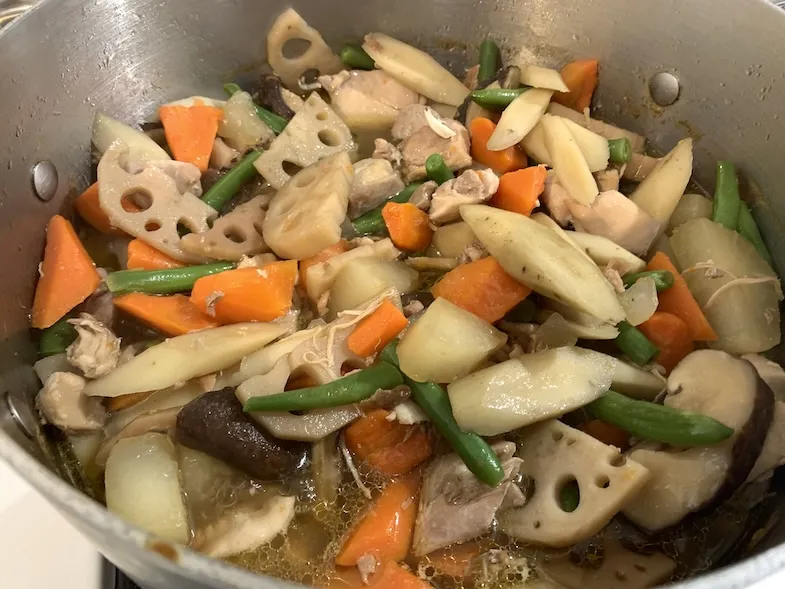
Add your green beans or snow peas and cook for an additional 5 minutes. Serve in a large family bowl.
Gluten-Free Chikuzenni Recipe (8 -10 servings)
Ingredients
- 600 grams chicken thigh or breast, cut into bite size pieces
- 300 grams daikon, cut into bite size pieces
- 300 grams renkon (lotus root), cut into bite size pieces. (If using fresh peel and rinse. If using frozen then thaw.)
- 300 grams carrot, cut into bite size pieces
- 300 grams gobo (burdock), cut into bite size pieces
- 8 dried shiitake mushrooms, soaked in boiling water, cut into bite size pieces
- 50 grams green vegetable such as snow peas or green beans
- 1 block of konnyaku, cut into bite-size pieces. (rinse, boil for a few minutes and rinse again) Optional: I can't always find it where I live.
- 2 - 3 Tablespoons vegetable oil, to fry the chicken
Ingredients for Cooking Broth
- Soaking mushroom liquid (strained), and enough water to make around 3 cups
- 1 - 2 teaspoons powdered dashi
- 6 - 7 Tablespoons gluten-free soya sauce
- 2 - 3 Tablespoons sugar
- 2 Tablespoons sake
- 3 Tablespoons mirin
- Note: I adjust the seasonings as needed after cooking and tasting. Sometimes I add more sugar and sometimes more gluten-free soya sauce.
Directions
- Soak the dried shiitake mushrooms in boiling water. Enough to cover them. Put a small bowl on top to push the mushrooms into the liquid. Soak until soft. This takes about 20 minutes, depends on the thickness of the mushrooms. Then squeeze out the liquid and remove the stem and cut into bite-size pieces. Keep the soaking liquid to add to the cooking broth later.
- Wash, peel and cut the vegetables into bite-size pieces.
- If using frozen renkon (lotus root) then thaw it out.
- If using frozen green beans, thaw and cut into about 1 inch (2.5 cm) lengths.
- If using snow peas then top and tail and slice in half.
- If using konnyaku. Rinse, then boil for a couple of minutes in water, drain and rinse. This removes the smell. Cut into bite size pieces.
- Now the vegetables are prepped, move on to the chicken. Cut into bite-size pieces and fry in the vegetable oil. I use whatever type of chicken I have such as thigh or breast. If you like the skin you can cook with the skin on.
- Once the chicken is brown, add the vegetables, except the green beans or snow peas, add the konnyaku and stir. Saute the vegetables for about 5 minutes.
- Add the mushroom soaking liquid, water and dashi and other broth flavourings. Bring to a boil and then cover and simmer for about 35 to 45 minutes. You want the broth volume to have decreased by half and the vegetables to be tender.
- Add your green vegetables and bring to a boil, then simmer with the lid off for about an additional 5 minutes.
- Serve in a large bowl with rice on the side.
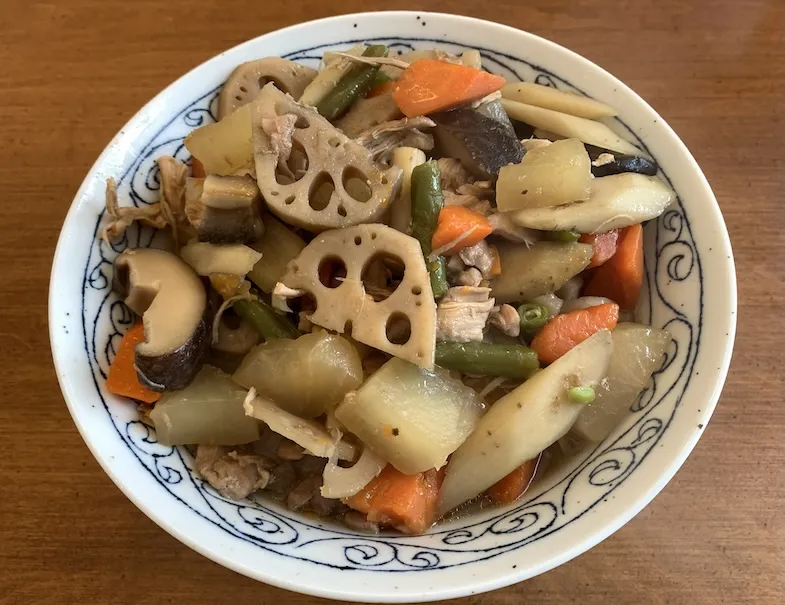
It is traditional in my family to serve in a large bowl. You can also serve in small individual bowls or separate the ingredients into groups and serve on a platter.
During Japanese New Year's this dish forms part of the New Year's bento box set and is served in one of the boxes. It is eaten cold as traditionally you don't cook for the first three days of the New Year.
Here is a link to another Japanese New Year's recipe if you are interested. It is for my Gluten-Free Soba Recipe.
Note: These are my personal experiences and opinions. Always seek out a medical opinion for medical concerns. Not sponsored. If sponsored I will always say so at the top of the post.